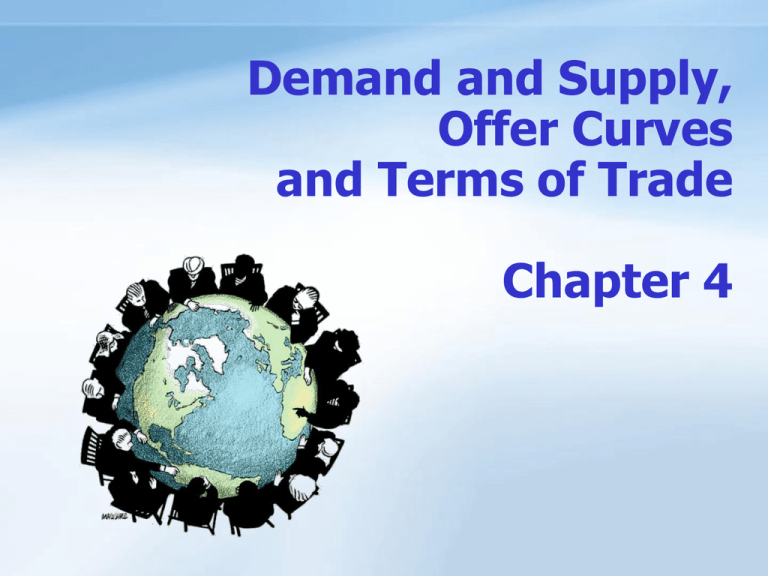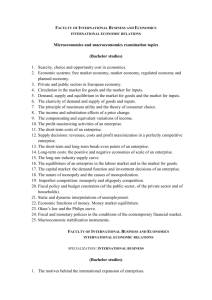Chapter 4 Demand and Supply, Offer Curves and the Terms of Trade
advertisement

Demand and Supply, Offer Curves and Terms of Trade Chapter 4 ANHUI UNIVERSITY OF FINANCE & ECONOMICS 1/17 1 Introduction Derive the demand and supply curve, derive offer curves for the two nations, and determine the equilibrium volume of trade and the equilibrium relative commodity price; Make partial equilibrium analysis to derive the relative commodity price with trade; Make general equilibrium analysis to derive the offer curves; Analyze the interaction of the offer curves of the two nations; Discuss the terms of trade. ANHUI UNIVERSITY OF FINANCE & ECONOMICS 2/17 1 Introduction • • • • Offer curves Terms of demand Commodity or net barter terms of trade General equilibrium model ANHUI UNIVERSITY OF FINANCE & ECONOMICS 3/17 2 Partial Equilibrium Analysis Partial equilibrium analysis utilizes the demand and supply curves to derive the equilibrium relative commodity prices. It deals with the market for one commodity, either X or Y. It does not consider the mutual influence of the two commodities. ANHUI UNIVERSITY OF FINANCE & ECONOMICS 4/17 2 Partial Equilibrium Analysis ANHUI UNIVERSITY OF FINANCE & ECONOMICS 5/17 3 Offer Curves An offer curve of a nation shows how much the nation is willing to export and how much the nation is willing to import at various relative commodity prices. The offer curve can be derived rather easily from the nation's production frontier, its indifference map, and the various relative commodity prices at which trade takes place. ANHUI UNIVERSITY OF FINANCE & ECONOMICS 6/17 3.1 Derivation of Offer Curves of Nation 1 ANHUI UNIVERSITY OF FINANCE & ECONOMICS 7/17 3.2 Derivation of Offer Curves of Nation 2 ANHUI UNIVERSITY OF FINANCE & ECONOMICS 8/17 4 General Equilibrium Analysis The intersection of the two curves defines the equilibrium relative commodity price at which trade takes place between them. Only at this equilibrium prices will trade be balanced between the two nations. At any other relative commodity price, the desired quantities of imports and exports of the two commodities would not be equal. This would put pressure on the relative commodity price to move toward its equilibrium level. ANHUI UNIVERSITY OF FINANCE & ECONOMICS 9/17 4 General Equilibrium Analysis Equilibrium Relative Commodity Price with Trade ANHUI UNIVERSITY OF FINANCE & ECONOMICS 10/17 5 Equilibrium Relative Commodity Price with Partial Equilibrium Analyses ANHUI UNIVERSITY OF FINANCE & ECONOMICS 11/17 5.1 Comparison between Partial & General Equilibrium Analysis ANHUI UNIVERSITY OF FINANCE & ECONOMICS 12/17 5.1 Comparison between Partial & General Equilibrium Analysis Both analyses are derived from the nation's production frontiers and indifference maps, and they show the same information. But in general equilibrium analysis, we consider all markets together, not just the market for commodity X. This is very important because changes in the market for commodity X affect other markets and these may give rise to important influence on the market for commodity X itself. On the other hand, the partial equilibrium analysis only uses demand and supply curves. It does not consider the influence and the connections that exist between the market for commodity X and the market for all other commodities in the economy. ANHUI UNIVERSITY OF FINANCE & ECONOMICS 13/17 5.2 Usefulness of the General Equilibrium Model General equilibrium model shows the conditions of production in the two nations, the tastes or demand preference, the autarky point of production and equilibrium price in the absence of trade, and the comparative advantage of each nation. It also shows the degree of specialization in production with trade, the volume of trade, the terms of trade, the gains from trade and the share of these gains going to each of the trading nations. ANHUI UNIVERSITY OF FINANCE & ECONOMICS 14/17 6 Terms of Trade They are the ratio of the price index of its exports (Px) to the price index of its imports (PM ). This ratio is usually multiplied by 100 in order to express the terms of trade in percentage. An improvement in a nation's terms of trade is usually regarded as beneficial to the nation in the sense that the prices the nation receives for its exports rise relative to the prices it pays for imports. Commodity or net barter, terms of trade (N): N = (PX /PM )×100 N = (PX /PM ) 100=(100/120 )×100=83 ANHUI UNIVERSITY OF FINANCE & ECONOMICS 15/17 7 Questions for Discussion • What do offer curves show? How are they derived? What is their shape? What explains their shape? • What are the forces that push any nonequilibrium-relative commodity price toward the equilibrium level? • How is the equilibrium relative commodity price with trade determined with demand and supply curves? ANHUI UNIVERSITY OF FINANCE & ECONOMICS 16/17 Thank You ANHUI UNIVERSITY OF FINANCE & ECONOMICS 17/17

![[I-324] Topical Seminar on International Trade](http://s3.studylib.net/store/data/008957979_1-f57606cd75cb7b10de030dcd936eae4f-300x300.png)







